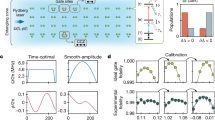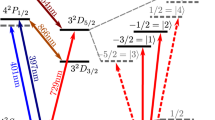Abstract
The circuit model of a quantum computer consists of sequences of gate operations between quantum bits (qubits), drawn from a universal family of discrete operations1. The ability to execute parallel entangling quantum gates offers efficiency gains in numerous quantum circuits2,3,4, as well as for entire algorithms—such as Shor’s factoring algorithm5—and quantum simulations6,7. In circuits such as full adders and multiple-control Toffoli gates, parallelism can provide an exponential improvement in overall execution time through the divide-and-conquer technique8. More importantly, quantum gate parallelism is essential for fault-tolerant error correction of qubits that suffer from idle errors9,10. However, the implementation of parallel quantum gates is complicated by potential crosstalk, especially between qubits that are fully connected by a common-mode bus, such as in Coulomb-coupled trapped atomic ions11,12 or cavity-coupled superconducting transmons13. Here we present experimental results for parallel two-qubit entangling gates in an array of fully connected trapped 171Yb+ ion qubits. We perform a one-bit full-addition operation on a quantum computer using a depth-four quantum circuit4,14,15, where circuit depth denotes the number of runtime steps required. Our method exploits the power of highly connected qubit systems using classical control techniques and will help to speed up quantum circuits and achieve fault tolerance in trapped-ion quantum computers.
This is a preview of subscription content, access via your institution
Access options
Access Nature and 54 other Nature Portfolio journals
Get Nature+, our best-value online-access subscription
$29.99 / 30 days
cancel any time
Subscribe to this journal
Receive 51 print issues and online access
$199.00 per year
only $3.90 per issue
Buy this article
- Purchase on Springer Link
- Instant access to full article PDF
Prices may be subject to local taxes which are calculated during checkout




Similar content being viewed by others
Data availability
All relevant data are available from the corresponding author upon request.
References
Nielsen, M. A. & Chuang, I. L. Quantum Computation and Quantum Information (Cambridge Univ. Press, 2011).
Cleve, R. & Watrous, J. Fast parallel circuits for the quantum Fourier transform. In Proc. 41st Annual Symposium on Foundations of Computer Science 526–536 (IEEE, 2000).
Maslov, D. Linear depth stabilizer and quantum Fourier transformation circuits with no auxiliary qubits in finite neighbor quantum architectures. Phys. Rev. A 76, 052310 (2007).
Maslov, D., Dueck, G. W., Miller, D. M. & Negrevergne, C. Quantum circuit simplification and level compaction. IEEE Trans. Comput.-Aided Design Integr. Circuits Syst. 27, 436–444 (2008).
Fowler, A. G., Devitt, S. J. & Hollenberg, L. C. L. Implementation of Shor's algorithm on a linear nearest neighbour qubit array. Quantum Inf. Comput. 4, 237–251 (2004).
Nam, Y. & Maslov, D. Low-cost quantum circuits for classically intractable instances of the Hamiltonian dynamics simulation problem. npj Quantum Inf. 5, 44 (2019).
Kivlichan, I. D. et al. Quantum simulation of electronic structure with linear depth and connectivity. Phys. Rev. Lett. 120, 110501 (2018).
Cormen, T. H., Leiserson, C. E., Rivest, R. L. & Stein, C. Introduction to Algorithms 3rd edn (MIT Press, 2009).
Steane, A. M. Space, time, parallelism and noise requirements for reliable quantum computing. Fortschr. Phys. 46, 443–457 (1999).
Aharonov, D. & Ben-Or, M. Fault-tolerant quantum computation with constant error rate. SIAM J. Comput. 38, 1207–1282 (2008).
Wineland, D. & Blatt, R. Entangled states of trapped atomic ions. Nature 453, 1008–1014 (2008).
Monroe, C. & Kim, J. Scaling the ion trap quantum processor. Science 339, 1164–1169 (2013).
Devoret, M. H. & Schoelkopf, R. J. Superconducting circuits for quantum information: an outlook. Science 339, 1169–1174 (2013).
Feynman, R. P. Quantum mechanical computers. Optics News 11, 11–20 (1985).
Draper, T. G., Kutin, S. A., Rains, E. M. & Svore, K. M. A logarithmic-depth quantum carry-lookahead adder. Quantum Inf. Comput. 6, 351–369 (2006).
Debnath, S. et al. Demonstration of a small programmable quantum computer with atomic qubits. Nature 536, 63–66 (2016).
Linke, N. M. et al. Experimental comparison of two quantum computing architectures. Proc. Natl Acad. Sci. USA 114, 3305–3310 (2017).
Mølmer, K. & Sørensen, A. Multiparticle entanglement of hot trapped ions. Phys. Rev. Lett. 82, 1835–1838 (1999).
Islam, R. et al. Emergence and frustration of magnetism with variable-range interactions in a quantum simulator. Science 340, 583–587 (2013).
Bohnet, J. G. et al. Quantum spin dynamics and entanglement generation with hundreds of trapped ions. Science 352, 1297–1301 (2016).
Kokail, C. et al. Self-verifying variational quantum simulation of lattice models. Nature 569, 355–360 (2019).
Friis, N. et al. Observation of entangled states of a fully-controlled 20 qubit system. Phys. Rev. X 8, 021012 (2018).
Zhu, S.-L., Monroe, C. & Duan, L.-M. Trapped ion quantum computation with transverse phonon modes. Phys. Rev. Lett. 97, 050505 (2006).
Zhu, S.-L., Monroe, C. & Duan, L.-M. Arbitrary-speed quantum gates within large ion crystals through minimum control of laser beams. Europhys. Lett. 73, 485–491 (2006).
Choi, T. et al. Optimal quantum control of multimode couplings between trapped ion qubits for scalable entanglement. Phys. Rev. Lett. 112, 190502 (2014).
Leung, P. H. et al. Robust 2-qubit gates in a linear ion crystal using a frequency-modulated driving force. Phys. Rev. Lett. 120, 020501 (2018).
Green, T. J. & Biercuk, M. J. Phase-modulated decoupling and error suppression in qubit-oscillator systems. Phys. Rev. Lett. 114, 120502 (2015).
Lu, Y. et al. Global entangling gates on arbitrary ion qubits. Nature https://doi.org/10.1038/s41586-019-1428-4 (2019).
García-Ripoll, J. J., Zoller, P. & Cirac, J. I. Trapped ion quantum computation with transverse phonon modes. Phys. Rev. A 71, 062309 (2005).
Figgatt, C. Building and Programming a Universal Ion Trap Quantum Computer. PhD thesis, Univ. of Maryland (2018).
Sackett, C. A. et al. Experimental entanglement of four particles. Nature 404, 256–259 (2000).
Lin, G.-D. et al. Large-scale quantum computation in an anharmonic linear ion trap. Europhys. Lett. 86, 60004 (2009).
Landsman, K. A. et al. Two-qubit entangling gates within arbitrarily long chains of trapped ions. Preprint at https://arxiv.org/abs/1905.10421 (2019).
Olmschenk, S. et al. Manipulation and detection of a trapped Yb+ hyperfine qubit. Phys. Rev. A 76, 052314 (2007).
Acknowledgements
We thank S.-T. Wang, Z. Gong, S. Debnath, P. H. Leung, Y. Wu and L. Duan for discussions. Circuits were drawn using the qcircuit.tex package. This work was supported by the ARO with funds from the IARPA LogiQ programme, the AFOSR MURI programme and the NSF Physics Frontier Center at JQI. This material is partially based on work supported by the National Science Foundation during D.M.’s assignment at the Foundation. Any opinion, finding, and conclusions or recommendations expressed in this material are those of the authors and do not necessarily reflect the views of the National Science Foundation.
Author information
Authors and Affiliations
Contributions
C.F., A.O., N.M.L., K.A.L., D.M. and C.M. designed the research; C.F., N.M.L., K.A.L., D.Z. and C.M. collected and analysed the data; C.F. performed the theory derivations; A.O. performed the pulse sequence optimizations; C.F., A.O., N.M.L., K.A.L., D.Z., D.M. and C.M. contributed to the manuscript.
Corresponding author
Ethics declarations
Competing interests
C.M. is co-founder and Chief Scientist at IonQ, Inc.
Additional information
Publisher’s note: Springer Nature remains neutral with regard to jurisdictional claims in published maps and institutional affiliations.
Extended data figures and tables
Extended Data Fig. 1 Additional experimental gate fidelities for parallel two-qubit entangling gates.
a–d, Parity curves used to calculate fidelities for parallel XX gates applied on several sets of ions. Circles indicate data, with matching-colour lines indicating calculated fits. The key specifies the ion pair corresponding to each parity curve. The six parity curves shown in each plot include the two gate ion pairs (the first two ion pairs in the key) and the four crosstalk ion pairs. a, Ions (1, 2) and (3, 4) yield fidelities of 98.4(3)% and 97.7(3)% for the respective entangled pairs, with an average crosstalk error of 0.6(3)%. b, Ions (1, 5) and (2, 4) yield fidelities of 96.8(3)% and 98.1(2)% for the corresponding entangled pairs, with an average crosstalk error of 1.7(3)%. c, Ions (1, 3) and (2, 5) yield fidelities of 98.3(3)% and 97.5(2)% for the respective entangled pairs, with an average crosstalk error of 0.8(4)%. d, Ions (1, 2) and (4, 5) yield fidelities of 97.2(3)% and 91.9(3)% for the corresponding entangled pairs, with an average crosstalk error of 0.9(3)%.
Extended Data Fig. 2 Experimental gate fidelities for parallel two-qubit partially entangling gates.
Parity curve for parallel XX(χ) gates on ions (1, 5) and (2, 4), where an XX(π/4) gate is applied on ions (1, 5) and an XX(π/8) gate on ions (2, 4). Circles indicate data, with matching-colour lines indicating calculated fits. The key specifies the ion pair corresponding to each parity curve. The six parity curves shown include the two gate ion pairs (the first two ion pairs in the key) and the four crosstalk ion pairs. The data yield fidelities of 96.4(3)% and 99.4(3)% for the respective entangled pairs, with an average crosstalk error of 2.2(3)%.
Extended Data Fig. 3 Independence of parallel-gate calibration.
Parallel gates can be calibrated independently. a–d, Data obtained by applying a pair of entangling gates in parallel and observing the change in population for each pair as the scaling factor for one of the ions or gates is varied. The key specifies the ion pair state corresponding to each dataset; for example, ‘(1, 2) 00’ indicates the 00 population for ions (1, 2). The 01 and 10 populations are very close to 0 and hence not always visible. The error bars are statistical. a, Scan of the scaling factor on ion 1 with an entangling gate on ions (3, 4). b, Scan of the scaling factor on ions (1, 2) with an entangling gate on ions (3, 4). c, Scan of the scaling factor on ion 2 with no light on ions (3, 4). d, Scan of the scaling factor on ions (1, 2) with no light on ions (3, 4).
Extended Data Fig. 4 Full-adder implementation.
Application-optimized full-adder implementation using XX(χ), Rx(θ) and Ry(θ) gates, where θ is the rotation angle applied by the single-qubit R gate. The two parallel two-qubit operations are outlined in dashed boxes.
Extended Data Fig. 5 C(V) gate implementation.
Implementation of the \(C(V)=\sqrt{{\rm{CNOT}}}\) gate using XX(χ), Rx(θ) and Ry(θ) gates. The gate is used to construct the full adder used in this work.
Supplementary information
Supplementary Information
This file contains the following sections: Constraint problem for optimal parallel operations; Optimization methods; Fidelity of parallel xx operations; Toward a single-operation GHZ state; calculating fidelities of 2-qubit entangling gates.
Rights and permissions
About this article
Cite this article
Figgatt, C., Ostrander, A., Linke, N.M. et al. Parallel entangling operations on a universal ion-trap quantum computer. Nature 572, 368–372 (2019). https://doi.org/10.1038/s41586-019-1427-5
Received:
Accepted:
Published:
Issue Date:
DOI: https://doi.org/10.1038/s41586-019-1427-5
This article is cited by
-
Quantum Poisson solver without arithmetic
Intelligent Marine Technology and Systems (2024)
-
Observation of entanglement transition of pseudo-random mixed states
Nature Communications (2023)
-
Demonstration of three- and four-body interactions between trapped-ion spins
Nature Physics (2023)
-
Extensive characterization and implementation of a family of three-qubit gates at the coherence limit
npj Quantum Information (2023)
-
Error-mitigated quantum simulation of interacting fermions with trapped ions
npj Quantum Information (2023)
Comments
By submitting a comment you agree to abide by our Terms and Community Guidelines. If you find something abusive or that does not comply with our terms or guidelines please flag it as inappropriate.



